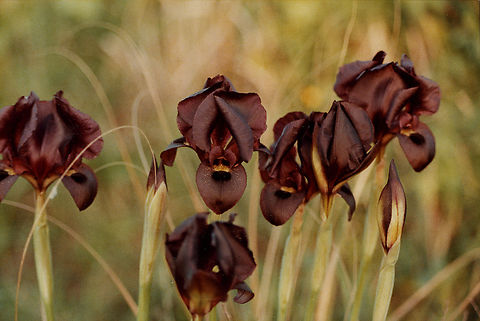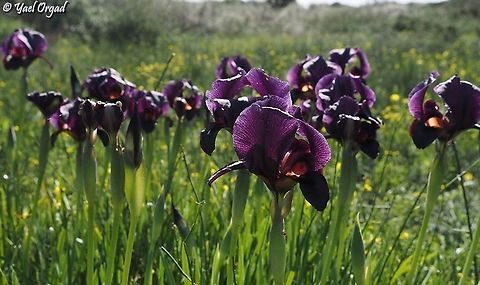
Appearance
It is a geophyte, with stout rhizomes, that are stoloniferous, forming long thin stolons, or secondary roots deep into the soil. The rhizomes are flush with the surface of the soil, so that they can feel the heat of the sun. They can form wide clumps of plants.It has glaucous and linear leaves, that are falcate, The grass-like, leaves can grow up to between 6–11 cm long, and between 0.5 and 0.8 cm wide. They are similar in form to "Iris iberica".
It has a slender stem or peduncle, that can grow up to between 15–25 cm tall. The stem has green, lanceolate spathes, which are 7.6 cm long.
The stems hold between 1 and 2 terminal flowers, blooming early spring, between February and March. In the UK, it flowers in May, In cultivation, it flowers later, between April and May. Compared to "Iris atrofusca" and "Iris hermona", it has floral longevity of.
The flowers are 8 cm in diameter, come in shades from orange, red-brown, dark burgundy, to purple, dark purple, or blackish purple. The flowers buds are usually black.
Like other irises, it has 2 pairs of petals, 3 large sepals, known as the 'falls' and 3 inner, smaller petals, known as the 'standards'. The narrow, falls are oblong shaped, and measure 3.6–6 cm long and 2.5–4 cm wide. They are usually a darker shade of colour than the standards. They do not have veining, due to the dark colour of the petals, but they do have a blackish, or darker signal patch, and in the middle of the falls, a row of short hairs called the 'beard', which are yellow, with purple tips. The rounded standards, are incurved, paler than the falls and measure 5–5.8 cm long and 4.5–6 cm wide. They also do not have veining, due to the shade of the petal.
It has style branch that is 3.5 cm long, with ovate crests. It has a green perianth tube, which is longer than the ovary. The flowers do not produce nectar, a reward.
After the iris has flowered, it produces a seed capsule, which has not been described.
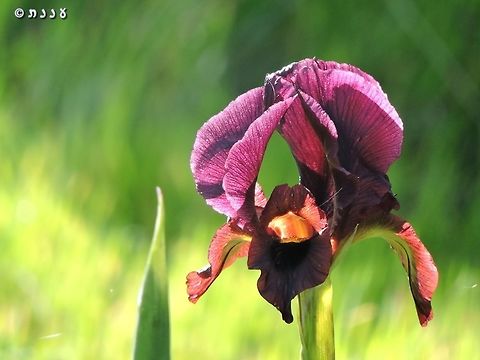
Status
Previously, the iris was widely found along the coast of Israel, but by the 1950s, the habitats of "I. atropurpurea" was drastically affected by citrus plantations, and urbanisation, which reduced the fragmented areas of light soils along the coast. Then by 1959, it was listed as threatened by extinction, as only a few populations of the iris were found in reduced areas.In 1964, a law was established in Israel to protect the ten species of iris endemic to the region. Then in 1963, the Nature Reserves acts was established, which was followed by the establishment of the Nature Reserves Authority in 1964, the authority enforces the act and manages the nature reserves.
In 1975, Agami and Dafni, listed the iris as 'threatened by real extinction'. Later in 1986, 9 species of iris were recorded in 'Flora Palestine' by Feinbrun. In 2000, ten species of iris, were classed as 'endangered'. A new protection law was established on 1 February 2001. Then in 2008, it was listed by Smida and Polak, in the Red Data Book as 'vulnerable', it was listed in 2012 as high conservation priority.
The iris is currently only found in nature reserves, such as the 'Irises Dora Rainpool nature park' near Netanya, which has the world's largest population of "I. atropurpurea".
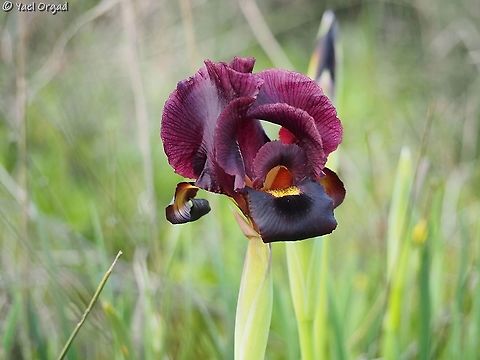
Habitat
It is native to temperate Asia.It grows on poor sandy soils, or mixed with gravel, such as found in old sand dunes and along the coastal plains.The iris and "Iris hermona" are found on lime-less soils. The species is normally found with, heliotrope, a figwort scabious and a number of grasses.
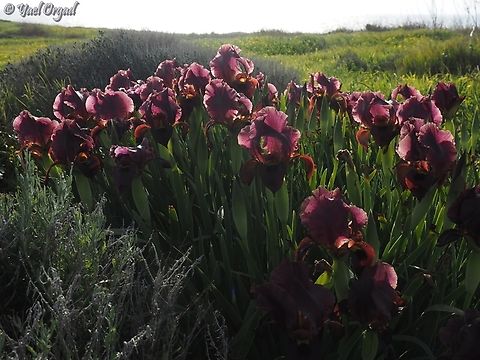
Defense
Like many other irises, most parts of the plant are poisonous, and if mistakenly ingested can cause stomach pains and vomiting. Also, handling the plant may cause skin irritation or an allergic reaction.References:
Some text fragments are auto parsed from Wikipedia.
